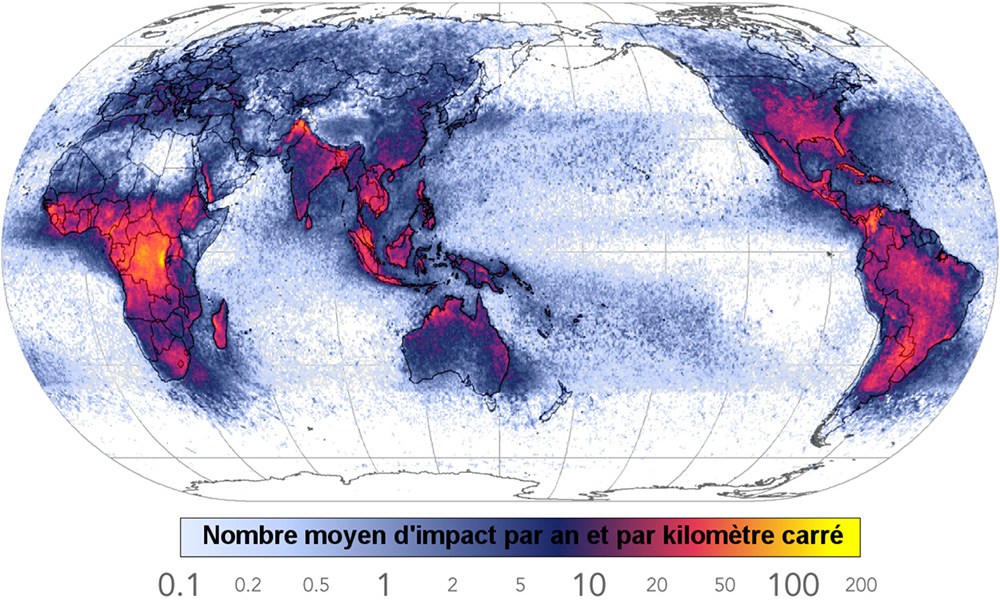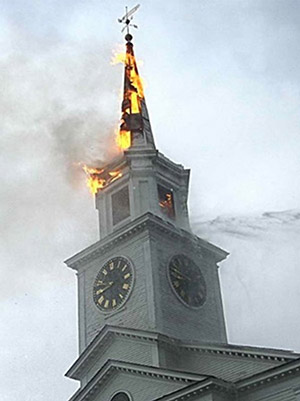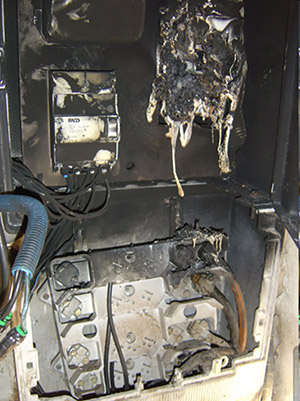
LIGHTNING PHENOMENON
Lightning tends to strike high altitude regions and prominent elements.
Thunder can resonate from a short crack when it is near, or rumbles away. As light travels faster than sound, the strike is appearing before thunder sound.
When electrostatic field exceeds the dielectric limits of the air (depends on the humidity and pressure conditions), a lightning discharge produces, with an acoustic wave: the thunder (caused by sudden dilation of the air which has been overheated by electrical air.)
The conception of a lightning protection implies to integrate the geographical and climatic conditions, in order to determine the exposure level of the structure to be protected.
LIGHTNING CURRENT FLOW

DIRECT EFFECTS
Induced mechanical effects during a lightning impact (distortions, break-off, destructions …).
Thermal effects (or « Joule effect ») at the impact point: generating fusion or destruction by exploding the material, or spot fires.
Electrochemical effects with chemical decomposition of the materials, by electrolytic reactions (negligible, most of the time in earthing systems)
Step potential which can provoke burns, respiratory failures or cardiac arrest for human beings or animals, when the lightning current passes through heterogeneous soils.

INDIRECT EFFECTS
Induced overvoltages during a direct lightning impact on an electrical line or pylon. The current is propagated and reaches all the installations distributed by the line, even if located at several km from impact point.
Induced overvoltages by electromagnetic radiation of lightning current on all nearby metal elements. Overvoltages and transient current appearing on all the connected elements. The effects are proportional to the intensity and proximity of the lightning strike.
Surge in tensions on the earthing system of the installation, when the current spreads into the ground, generating destructive potential difference between the masses of the equipments and connected networks
Earth potential rise of non-negligible lightning current dissipated by the earth of the air terminal, until earthing system of the installation.
PROTECTION REQUIREMENTS
To reduce and to protect from these effects (both direct and indirect), it is necessary to implement a state-of-the-art installation for External Lightning Protection System (ELPS) and Internal Lightning Protection System (ILPS), in conformity with the standards in force.
It is also necessary to pay particular attention to the earthing systems and interconnections with conductive elements near the air terminals conductors and electrical masses of the installation.
The storm detection network enables to determine the values of the lightning strikes density. When the density is unknown for any site, it can be deduced from Nk according the following equation: Ng = Nk/10.
Depending on the geographical situation, the type of electrical supply and presence or not of an air terminal, the overvoltage protection can be compulsory.
CONSEQUENCES, IN FRANCE
STANDARDS AND REGULATIONS
Lightning protection is a regulated field with many standards for which France Paratonnerres adheres when developing, marketing, and installing its products.
NF C 17-102 – 2011 Edition
Lightning Protection
This standard describes the set up regulations for the protection of structures and open areas for direct lightning strikes with E.S.E. air terminal.
EN 62305
Lightning Protection
This serie is divided into 4 volumes and explain, in a first time, the general principles of lightning, and gives a method of risk evaluation. The third volume describes the rules for the installation of the lightning protection, in order to protect the people and the building. Then, the final volume proposes the protection methods to reduce the risk of failure in networks and communications;
IEC/EN 62305-1
General principles
IEC/EN 62305-2
Risk evaluation
IEC/EN 62305-3
Physical damages to structures and life hazard
IEC/EN 62305-4
Electrical and electronic systems within structures
IEC 62561 / 50-164
Lightning protection components
This series is a “product” standard, which describes the technical characteristics to be respected by several lightning protection components. This series is divided into 7 volumes for different products :
IEC 62561-1/EN 50164-1
Requirements for connection components
IEC 62561-2/EN 50164-2
Requirements for conductors and earth electrodes
IEC 62561-3/EN 50164-3
Requirements for isolating spark gaps
IEC 62561-4/EN 50164-4
Requirements for conductor fastenings
IEC 62561-5/EN 50164-5
Requirements for earth electrode inspection housings and earth electrode seals
IEC 62561-6/EN 50164-6
Requirements for lightning strike counter
IEC 62561-7/EN 50164-7
Requirements for earth enhancing compounds
NF C 15-100
Low voltage electrical installations
This standard applies for all electrical installations supplied under or equal to 1000v in alternative current and 1500V in continuous current
EN 61643-11
Surge protector devices connected to low voltage distribution networks
This standard describes the requirements and tests enabling characterisation of surge protector devices connected to low voltage distribution networks
UTE C 17-108
Simplified Lightning Risk Analysis
This document is a guide describing a simplified method to analyse lightning risk. The method is inspired from the full lightning risk analysis, described in EN 62305-2. The method is defined as simplified because it only contains a limited number of parameters compared to the full method.
UTE C 15-712
Photovoltaic installations
This document is a guide describing the rules for installing photovoltaic generators connected to the low voltage public distribution network and not designed to work autonomously. It also gives the rules for installation of AC and DC surge protector devices, providing over currents and over voltages protection.
UTE C 15-443
Protection of law voltage electrical installations against over voltages of atmospheric origin or due to manoeuvres.
This practical guide indicates the conditions relative to the choice and implementation of surge protector devices in low voltage installations. It details and completes articles 443 and 534.1 of NF C 15-100 standard.


 Français
Français Espanol
Espanol